%2015%20Nov%202019%20by%20RCC.jpg?role=personal)
Our Thailand family home is located in the mountains northeast of Lampang, an important city in the history of northern Thailand with a population of about 58,000 people. The area of these mountains contains 37 villages with a population of about another 38,000 people. As you drive on the major highway that passes through these mountains, you would not think there could be that many people nearby, as tall trees and jungle mostly block the view of the villages from the highway.
The economy of these mountain villages is dominated by the largest coal mine in Thailand, which supplies it's lignite coal to a very large power generating plant nearby. Big plans are afoot about these major sources of jobs for the locals since 1978. The future plans are far from being completed. There is a very large and modern museum near the mine itself.
The Lampang Museum in the heart of Lampang is an outstanding museum for learning about the history of the region. It would be a good starting point for exploring the area. Lampang has been an important trading area, first by way of the river and then from the train line. Every Saturday night there is a night market in this same trading area, near a historical bridge on the river and the most popular restaurant for locals is in that area too.
It is said that you haven't been to Lampang until you have taken a ride in one of the many horse drawn carriages that can be found in Lampang and nowhere else in Thailand. It is a great way to see the downtown up close at a pleasant slow pace.
Important Buddhist temples to visit in Lampang.
- Wat Phra That Lampang Luang - the grand temple of Lampang, mostly built in the 15th century, before Columbus landed in North America, with one building built in the 13th century. Everyone who comes to Lampang must visit this site. Its buildings are thought to be the oldest standing wooden structures in all of Thailand. It is one of the best examples of Lanna style architecture in Thailand. The fortification wall around the temple was built in the 8th century, so the area started out as a frontier area, not as a monastery, and in the early 18th century it was invaded and occupied by Burmese troops, until it was liberated by a local hero. Bullet holes where the Burmese commander was killed can still be seen. The location is actually 18 km southwest of Lampang in Ko Kha. When you visit the Lampang Museum, you will learn that Ko Kha was one of only three places on the planet where a fossil of Homo erectus was found, now effectionately known as Lampang Man. Spend some time reading about this temple before you go there to more fully appreciate what you see when you are there.
- Wat Phra Kaew Don Tao, the temple famous for having held the most sacred Buddha image in Thailand for 34 years, the Emerald Buddha. There is also a statue of the elephant in the 15th century that insisted upon bringing the Emerald Buddha from Chiang Rai to Lampang, rather than to Chiang Mai. In the end, the Emerald Buddha ended up residing at the Royal Palace in Bangkok. The word emerald refers to the green color of the statue, not to the type of stone from which it was carved.
- Wat Chedi Sao Lang, the temple famous for its 20 white chedis. On Saturdays they also have a building open where local artisans produce beautiful hand-made cloth with a wooden loom. So go on a Saturday and see the loom early in your visit, as they close at 4:30 in the afternoon.
- Wat Phra That Doi Phra Chan has two temples, one in the valley just off the highway in a lovely rural neighborhood and a second one way up the mountain, a hike up 650 concrete steps through the forested mountainside being the way we went. These are very recently built temples, gleaming in gold, very tastefully executed with fantastic views of the large valley of rice fields and mountain ranges in the distance. There is actually a road to the top, which is what we will use next time, as the hike up the stairs is a very rigorous hike, but very much worth the trouble when you see what is there. The drive to the site of the temples is one of the best drives we've taken in Thailand, as the entire valley can be seen most of the way, rather than a highway with tall trees and jungle on both sides of the highway obstructing the view of the homes and the agricultural valley.
- Wat Chaloem Phre Kiat - while this is a Buddhist temple 800 meters up, on top of a mountain, the experience of it is more like a very rigorous, but safe, mountain climb, most of it up metal steps with metal railings firmly secured to the rock of the mountain, rather than a visit to a temple. We succeeded in making the hike more than four years ago. I had serious concern about whether I would be able to make it all the way, but I made it and I'm glad I did. Now that I am older, I would not attempt it again. As I was the oldest one in our group, I had the distinct advantage of being able to ride up front with the driver, rather than sitting in back on the bench seats in the songthaew on the very steep and sometimes narrow road up to the starting point for the final walk up to the mountain top. This video is a very good account of the experience of visiting this destination. Note that the numerous white pagodas seen in the video are not accessible along the way on the hike. I would also not encourage anyone to make the hike in the rain. And please be sure to take a water bottle for each hiker, if you go there.
Other excellent destinations near Lampang follow
Elephant Conservation Park is where we go to see elephants. It is owned and run by the Thai government, so we hope that the animals are treated well, which seemed to be the case from what we saw. There are shows for the tourists and the option to pay extra to take a ride on an elephant. But there is another elephant preserve in Chiang Mai that does not offer rides on the animals.
Chae Son National Park - is a 768 square kilometer national park in the northeast corner of Lampang province. It is a very popular destination for the locals, especially for its hot springs, which are used to cook eggs in baskets in the springs at an average temperature of 73 degrees Celsius. There are also private buildings nearby for soaking in mineral water from the springs at 39 to 43 degrees Celsius.
Cover image - #1492 on larger Sony camera - of temple & valley in the background.
Check out this amazing map of roads in Thailand. Be sure to click on the image to blow it up.

What a great day I had in Thailand yesterday! It was the day my brother arrived at the Lampang airport to travel with us for five weeks. But what really capped off the day as a winner came about from exchanging $500 into Thai baht at a bank in Central Mall. I wrote about the perils of this activity earlier.
I used a different approach this time. First, I selected a bank that had their tellers sitting at a desk, with chairs at the desk so the customers could also sit. I've learned this can take a while, so I wanted to be comfortable. They had two customer chairs, so I had Supattra sit down with me. In the past, I had always done this on my own. This time the teller was able to chat with Supattra in Thai, which made it a much more relaxed activity. I mostly maintained a fun playful attitude.
I had selected five perfect C Notes and put them inside my passport before we even sat down. As we were sitting down, I placed these onto the desk in front of the teller and told her I wanted to "exchange these for Thai baht" with a big smile. She nodded and immediately went into her required routine of carefully examining the front and back of each bill. Of course I had made sure she could find no flaws, so when she finished her inspection, it was obvious we had a done deal. She then went though her required motions: making a copy of my passport, having me sign a few papers, typing details into her computer, printing the transaction voucher & finally counting out the Thai currency. Because she was making quick work of this, I didn't even look for flaws on any of the Thai currency. But I DID count the money she gave me to make sure it matched the voucher she also had given me. I think she counted the five C Notes three or four times while I did this. Finally I asked for an envelope, which she provided and I thanked her in English, as I loaded the dough into the envelope.
Then The Best Part Ever! I spoke two Thai phrases to her with sincerity, just about the only Thai words I even know. I said "Thank you" and "Goodbye." She looked startled and pleased, nodding while saying much the same back to me and then spoke to Supattra in Thai. She was clearly very happy with how things had gone and so was I. As we made our retreat, I asked Supattra what the teller had said at the end.
She said, "He speaks really good Thai." This made my day, a really great day for me in Thailand. I started rejoicing, with Paula laughing along with me, as we both know how very little Thai I can speak or even understand!! I had managed to use just about the only Thai language I know just at the right time.

Yesterday around 4:00 pm we had one of the Thailand thunderstorms that I really love. I was relaxing upstairs in the main living area of our family home with all the wooden window shutters wide open. It was a hot, but not super hot, sunny day, probably in the low 80's. With the shutters all open, it's almost like being outside.
Then I heard some thunder, not too close. It was still sunny, so I went back to my reading. Before long the sky was cloudy and the thunder was closer and more frequent. There was one really loud thunder clap, always the best part, and some wind and rain had begun. The roof extends quite a distance past the edge of the house, so if the rain is coming straight down, having the shutters open is not a problem. The wind picked up quite a bit and it was getting exciting. The winds were cooling things off considerably and now I was thoroughly enjoying nature at work.
But then Aun Aun came into the room and started closing shutters. Of course the concern is that we don't want rain blowing in onto the wood floor. I had to admit she was taking the sensible course, because it was now raining really hard and the winds were whipping about. Which made it all the more fun to watch, but soon I realized I better get in line. So I also closed the three shutters closest to where I was sitting. That killed off much of the fun, because with the shutters closed, it is a very closed in space, as there are no glass windows for looking out.
So I moved to the kitchen, which is on one end of the house, but not fully enclosed. There are openings in the outer wall up above the cooking area and a large open area where the dishes are washed. I think the idea is to make it easy for the strong cooking smells to escape out of these openings. On the side next to the kitchen table where we eat, there are two more wooden shutters that swing out. They remained open, so I was able to watch the downpour, which was considerable, from there, breathing in the fresh smell of the pouring rain. All the green foliage around the front of the house was glistening in the rain and I imagined many happy plants saying "Thank you!"
After about forty minutes of the storm, I looked far off in the distance and could see blue sky. During the next ten minutes, the rain subsided and soon it was all over. It had been fun, a lot like sitting out a thunderstorm in a forest while camping.
The image of gathering storm clouds is from Wikimedia.
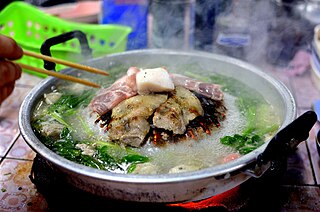
Last night we went to dinner at a popular barbeque restaurant in Lampang, Blue Mukata. It is an all-you-can-eat buffet where you cook the dinner yourself using a metal cooker sitting in the middle of the table, which has burning charcoal in its bottom. It's a very clever device. These are not gas burners piped to every table. No, these devices have hot burning charcoal in the bottom and they are carried to the table on a long forked device by the fire specialist at the restaurant. The metal dome in the middle gets super hot, making a hot surface for cooking sliced meat, especially pork. A large cube of fat is put at the very top of the dome, which then lubricates the cooking surface as the fat gets hot. Meanwhile there is a rim around the dome which holds water poured from a tea pot. This hot water is then used to boil vegetables and eventually make soup.
This was invented by the Thai people, a variation of the Korean barbeque grill and the Chinese hot pot. It is called Mu kratha, meaning pan pork. Thai folks really love pork, my wife's favorite meat by far. The restaurant is a large open pavilion, which is a good thing, as all those charcoal cookers put out a lot of heat. We ate there one afternoon when a cloudburst of rain let loose. The rain was banging on the metal roof and soon making its way through roof imperfections onto the dining area below. It was pretty exciting. We had to move over a few feet to avoid one waterfall of rain. But everyone took it in stride, continuing to cook and eat, while the staff scurried about mopping up the water on the floor and moving tables as needed.
This place also has a freezer with tubs of yummy ice cream. Grab as much as you want of that too. They also had round bite-size eclairs to go with the ice cream. Ohhh my! The total tab for the four of us was just under $7 each (800 baht). That's a good example of how affordable delicious food is in Thailand.
The image of the Mu kratha cooker came from Wikimedia. You can barely see the burning fire at its bottom. Follow the link to the Blue Mukata restaurant above and you can see some even better images taken by Nattakan Ruenpan.

I just discovered a very thorough Guide to the Bangkok Suvarnabhumi Airport. Yes, it does tell one how to pronounce the name and it's not a bad idea to practice saying it a bunch of times, as an American would never in a million years get the pronunciation right by looking at the word. I remember asking a woman on the staff of the airport to pronounce the name for me one time. She readily told me how to say it, but I didn't practice it enough, because I soon forgot it.
And it also tells what each level of the airport is for, which is pretty basic information. Just today I called my brother's hotel to ask them where he would catch the shuttle bus to the hotel upon his arrival. The answer was Level 2, between Gate #3 and #4. But we didn't know which level he'd be on when he arrived! If we had consulted this Guide, we would have known the answer to that one right away.
It occurs to me that it wouldn't be a bad idea to spend a good part of a day taking a tour of the public areas with this guide in hand. Hey, it's not essential, but it would be nice to increase one's familiarity with the place, especially if one is gonna use the airport a lot.
The image of Sala (Thai pavilion) at Suvarnabhumi Airport - between the C and D gates - was taken by Roger Price and was found on the Wikimedia Commons website.
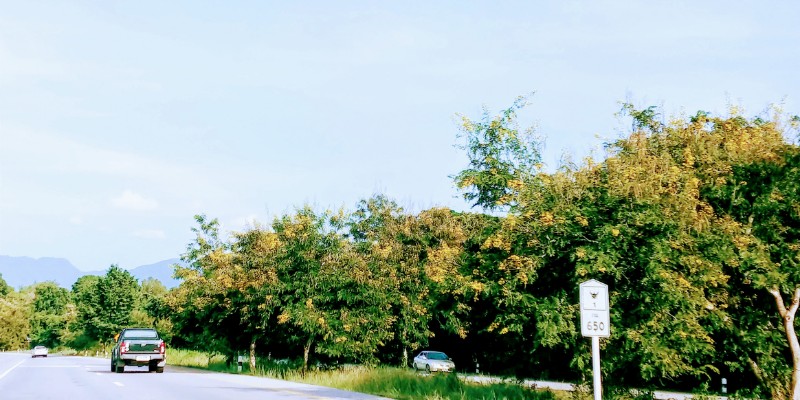
We have returned to the family home, now posting about Thailand again from inside Thailand. It took ten hours for us to drive up from The Pool Resort in Bangkok to the suburbs of Lampang. We have made that drive many times, but for some reason the mountain road of AH1 then AH2 from Kamphaeng Phet Province through Tak Province and Lampang Province really struck me with its beauty this time. The city of Kamphaeng Phet is the approximate midpoint of the drive from Bangkok to Chiang Mai, with a complete change in the character of the drive starting there. South of that midpoint you are driving through Central Thailand with rice fields the whole way and the highway lined with villages and commerce all along the whole way. As you go north, the elevation increases, the rice fields are not as evident, villages and commerce along the road begin to disappear, and eventually you are driving on a well-maintained highway lined with the teak trees with their large elephant ear leaves and the jamjuree trees, which are gorgeous wide-canopied trees with large symmetrical crowns. These are my two favorite varieties of trees in Thailand. Driving through them for much of the length of Tak Province and then well into Lampang Province is really delightful. In fact, this time I decided this is my favorite drive in Thailand. As you approach the City of Lampang, the road begins to descend in elevation and the mountainsides come into better view in places. This descent reminded me of the similar descent on the Grapevine as one drives north into the Los Angeles area on I-5.
The image of the drive past blooming trees was taken by Ron Chester on 23 Oct 2019 on AH2 as we were beginning the descent to Lampang.
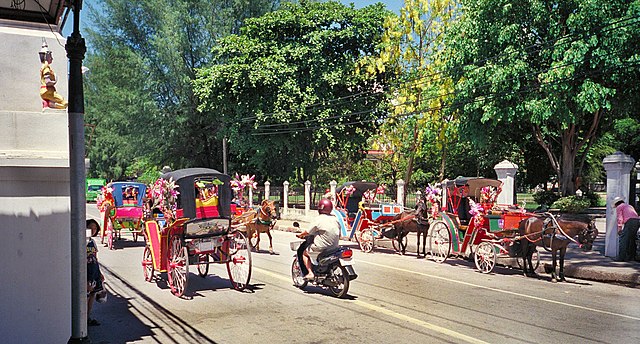
Supattra grew up in Northern Thailand and of course we've visited a lot of the great destinations in the North. Here is an article that highlights ten of the most popular spots in the North, all of which we have visited and we will surely take you to see some of them, while you are in Thailand too. Let us know if there are some that especially appeal to you.
The family home is in the mountains above Lampang, which is the area where Supattra grew up and an area where people have lived for more than 1,000 years. Lampang is the only city in Thailand that still offers horse and buggy rides around the town, which is a lot of fun. If you'd like to take one of those rides, we will surely do it. It is much more relaxing than a Tuk-Tuk ride in Bangkok. If you read the Wikipedia article on Lampang, you'll learn that the area was at the heart of the Lanna Kingdom, subject to Burmese control, until the natives rose up against the Burmese rulers and became a part of Siam during the reign of the great Thai King, Rama V.
The image of the Lampang carriages is from Wikipedia.

Back in August in my Recent News posting, I posted a link to an article that said the Thai Baht has been strong against the US Dollar. This got me wondering whether we would still see the ridiculous low prices for housing and food in Thailand when we travel there next.
Well today I read a very recent update on that topic. It is written by a young expat from the US, living in Chiang Mai, which is the biggest city in the North, the 2nd largest city in all of Thailand. Chiang Mai is at best about a 1-1/2 hour drive from Supattra's family home, including a lovely winding road through the jungle and steep mountainsides. It can become a two hour drive when traffic is bad. I don't think there is any big difference in the cost of the basics in Chiang Mai, as compared to other places we will visit in Thailand. So I think this article should give us a very good idea of what food and housing is likely to cost us during our trip.
Read it here. I hope you enjoy it.
The highway sign image is from Wikipedia.
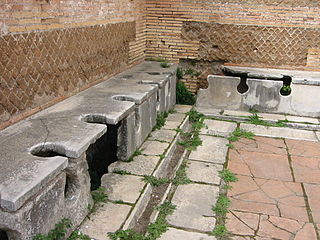
I'm hoping this posting might be very helpful to you. I know it would have been that way for me, as I had no clue about some of these things.
I'm just gonna let you read two articles on the Internet without comment.
Here's the first one to read.
Here's the second one to read.
Email me if you have any questions.

I've included another Thai learning video from Ying here, but not so you can learn the words necessarily, but as an example about the Thai culture regarding age.
This actually happened to me one time when I met one of Supattra's co-workers for the first time. He immediately asked me my age. This was puzzling to me at the time, but if I had understood the reason for his question, I would have been totally happy, as he was basically trying to determine whether I was older or younger than he was. Well, I'd say he was in his 40's, so he really wasn't sure whether I was older than that? I would take that as a huge compliment about my youthful appearance, as I was in my mid 60's at the time! Once I answered him, then he knew to call me P'Ron, rather than just Ron. P'Ron is pronounced Pee-Ron. I had earned that additional respect by revealing I was older than him. Of course, back in the States, it works the other way around: no respect at all, if you're OLD!
This posting shows another option with this blogging software. See the little headphones icon to the right of my name and W6AZ user ID? Well in this case, it gives you a second option for watching the video. You can do the customary thing of clicking on the text hyperlink (or right clicking to open it in another tab) OR simply click on the headphones icon. Easy!
The image of a marble bust of a 40 BC Roman man is from Wikimedia.
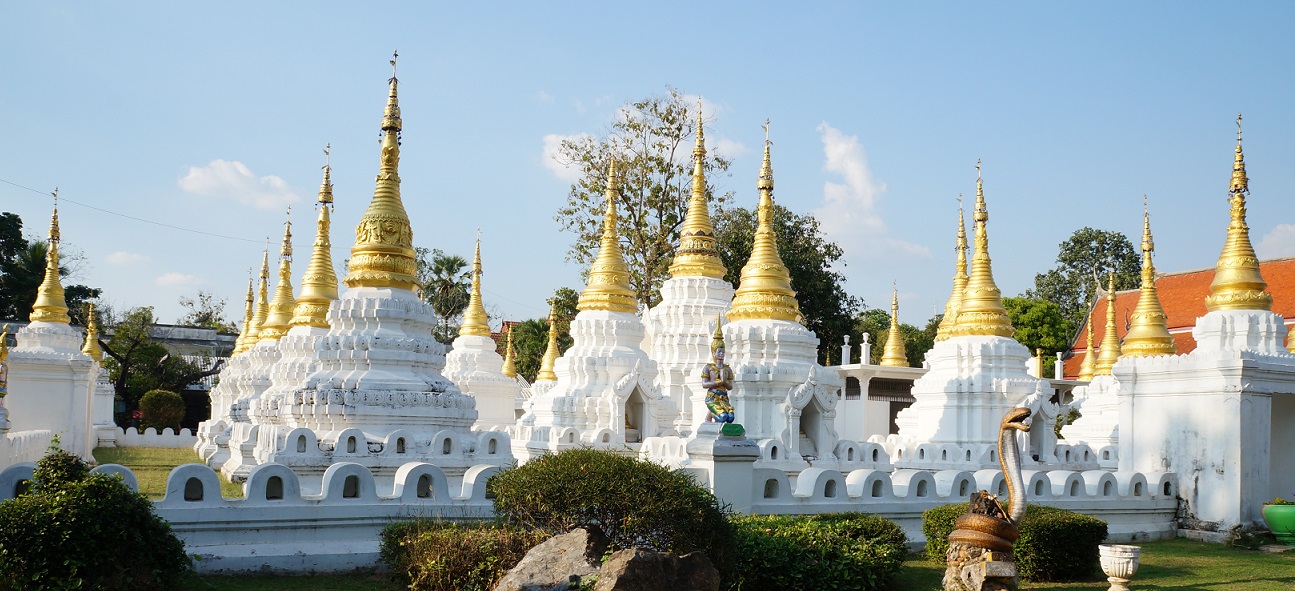
Thailand has over 41,000 Buddhist temples, of which nearly 34,000 are in current use. If you have a particular one in mind, you might be able to look it up on this Wikipedia page, which sorts them by region, a handy way to see what good temples might be nearby whenever you are in a particular area. I keep track of the provinces I have visited, but have no record of which wats I have seen, other than through my photographs and travel diary.
Every temple is unique, but there are certain components which recur in them. This article is a handy guide to the terminology of temples. You'll notice that a wat is defined as a temple complex, so it will have many of the structures shown in this article. I know many of these terms, but I'd like to learn them all. This guide is actually far more extensive than it looks at first. You can see examples of temples in many different regions, with pictures and descriptions of what each wat includes. I've never used these in the past, just appreciated each wat for what I could see. The wats themselves rarely have much in the way of commentary or written descriptions, especially in English, so for those who like to know more about what they are seeing, this could be a very useful guide. Sadly, if you don't have an Internet connection when you are at a site, you won't be able to read the guide.
The image of Wat Chedi Sao in Lampang, Thailand was taken 10 Dec 2014 and is copyright 2014 by Ron Chester. The name of the wat means Wat with Twenty Chedis. If you look carefully you can count the spires of all twenty chedis in this image. A picture taken by another was posted in Aug 2010. It does not show all twenty chedis. There are quite a few pictures of the temple on the web, but there is no clear agreement on how to spell the name in English.

One thing that was completely new to me when I arrived in Thailand was the presence of Spirit Houses, seemingly everywhere. These are a characteristic of Southeast Asia, not just Thailand. At first I thought they stemmed from the Thai version of Buddhism, as 95% of the Thai people are Buddhist. But I later learned that these had to do with Animism, not Buddhism, an even earlier tradition than Buddhism for the Thai people.
One good explanation about the Spirit Houses can be read here, written by an expat teacher in Thailand. It seems like one of the most expert authorities on the Thai tradition of Spirit Houses is another expat, born in California who used to spend her summers in Thailand as a kid. She has an excellent description of the subject on this page. She has a very extensive website about them, which you can explore once you've looked over her introduction to the subject. She was the first person who gave me any information about Spirit Houses when she appeared on the Bangkok Podcast (starting at 10:30) which I used to listen to a lot when I first got to Thailand. Listen to that podcast, it is quite excellent! I was very disappointed when that podcast came to an end. It was an excellent source of good information about Thailand.
I have one disagreement with what Marisa Cranfill says on that page I linked to on her website up above. She wrote, "Virtually no building in Thailand is erected without an accompanying spirit house." I know from my own experience that this is not an accurate statement, because there is no Spirit House on the property of my wife's family home and there never has been. BUT in the podcast there is a brief mention of a "consecrated pillar post" built into new buildings. My wife told me that her family home has a pillar post that was blessed by a monk from their nearby wat.
I find this to be a very interesting aspect of the Thai culture. The image of Spirit Houses is from Wikimedia.

I came across a useful article about some dress code rules in Thailand, especially for women. Of course the most common rule in Thailand is about removing one's shoes before entering a wat, the Thai word for one of their many temples. This rule is easy to follow, because you will always see a big collection of shoes outside the entrance to a temple. That's one reason I encouraged all of you to bring some good sandals along with you on your trip to Thailand.
I only ran afoul of the rules one time. We were exploring a very new and impressive wat. There was a very light rain as we came up the many steps to this amazing temple. The large marble expanse that extended from the top of the steps to the entrance to the wat was quite perfect and slick as glass from the rain. I made my way verrrry carefully and managed not to fall. My guess is they're going to have to deal with a lot of slip and fall incidents there.
Anyway, I was wearing a baseball cap to keep my head dry from the light sprinkle of rain. Once we had removed our footwear and went inside, the footing was good again. It was quite gorgeous inside and I did a lot of exploring. Suddenly a guy zoomed up toward me from out of the blue. He was not a monk, but clearly someone with authority. He came up pretty close and looked right at my cap and did a little nod. I don't remember whether he said anything, but the message was clear enough. I took off my cap, he nodded with a bit of a smile and was on his way.
I checked with Paula later and learned this is not a universal rule that applies to all wats, like the ban on footwear inside. And in fact it had never come up before in the many wats that we had explored. Maybe there had been a sign I had missed, but I was easily corrected about their local rule, so no big deal.
The image of the temple is by Bill Bradley, probably not the Knicks NBA star.
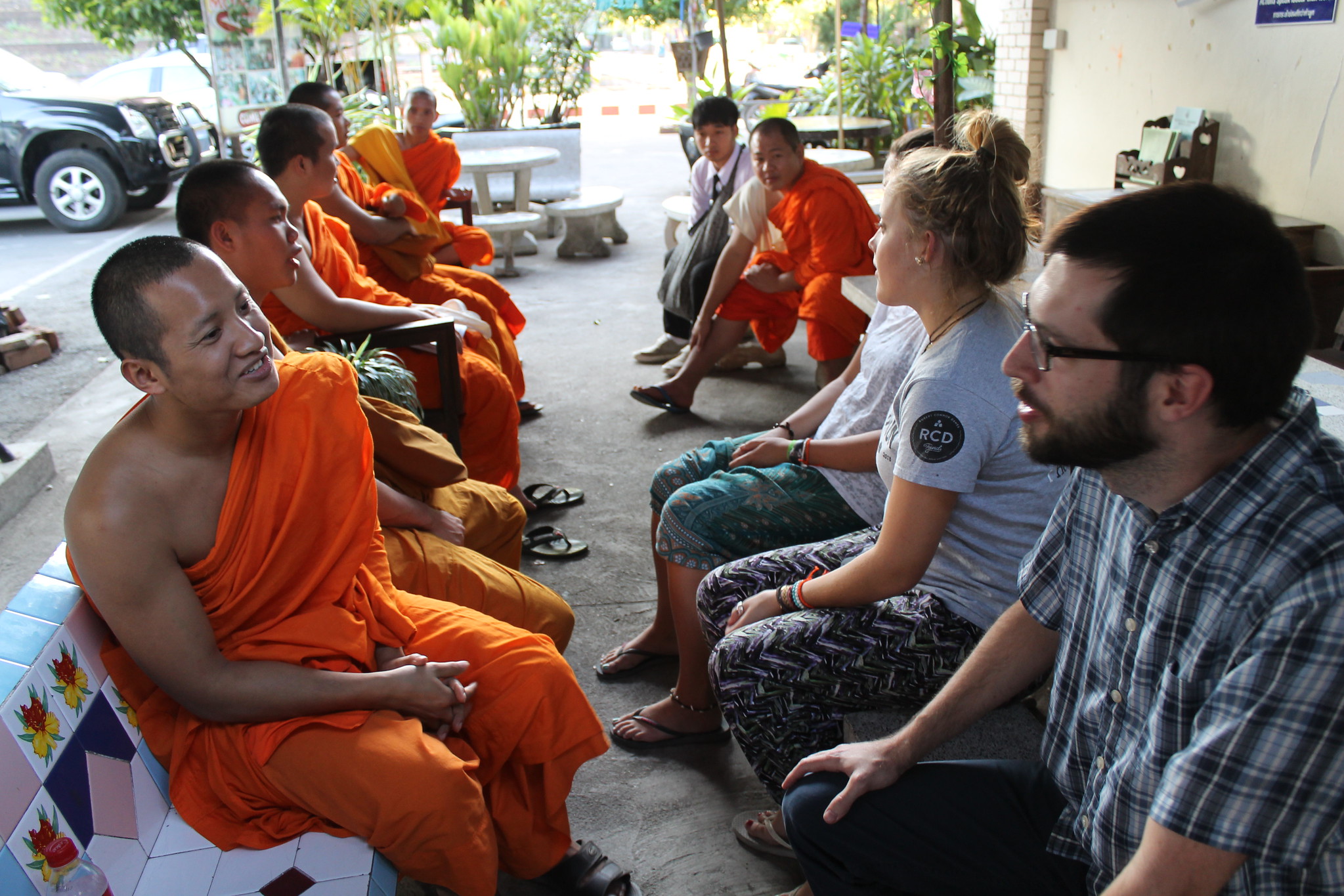
I looked for the simplest Thai learning video I could find. In all such videos, recognize that the spelling of Thai words in English can vary. Soooo just as in learning Morse Code, learn how it sounds, NOT how it is spelled. Remember, for the Thai person, they learned to spell it with their own Thai script, which we don't know. Wellll they might not know our English script either! If you ask them how a word is spelled in our language they could easily NOT be able to answer you. So see whether you can learn to duplicate the sound they are making. Here's a video to teach FIVE words. I don't think #3 or #5 are essential at all. I never learned either one of them. The others would be good to learn and she also shows you how to do a proper Wai, a bow of the head with the hands held together. Being polite is fundamental in communicating with Thai people. Check it out!
I found another video here about the same Thai words, with a native Thai teacher named Ying, teaching a farang named Paula. Ying has very good English, so she's pretty easy to understand. They posted a series of at least 37 lessons. You might want to scan over them to see if any other topics interest you.
In traveling with Supattra, I never had to rely on my ability to say any Thai words correctly! She took care of everything for me. But somewhere along the way, I learned to how to do a Wai and to smile a lot. That took care of pretty much everything. It will work for you too.
The image of the Thai monks in Chiang Mai is from ironypoisoning on flickr.

On the US website of the Royal Thai Consulate-General, Chicago is a document about the two most important Thai Kings, King Rama V (on the left) and King Rama IX (on the right). The document refers to them as the difference makers. I think this two page history is a good one to read. Both of these kings are verrrrry popular with the Thai people and you will see their photos often, in restaurants and elsewhere. We will point out some of these while you are in Thailand, so you will come to recognize their images. Wikipedia also has pages for King Rama V and King Rama IX. We bought a set of fine china in Thailand that is from the period of King Rama V, so you'll be able to see that when we are at the family home in Mae Moh. Originally this style of china was first produced in Thailand during the reign of King Rama V and it was only available to the royalty and his aristocracy, but later King Rama V gave permission for it to be obtained by anyone who had the means to purchase it.
The images of the kings are from the Royal Thai Embassy website in Chennai, India.
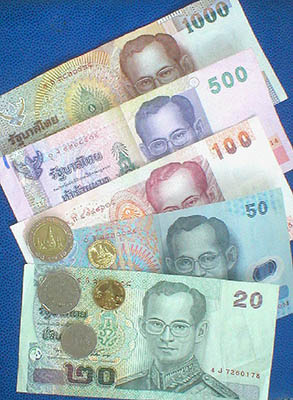
Traveling in a Group
When Supattra and I are traveling alone, I pay for everything, as it comes up. That's easy. But when we travel with our good friends from Bangkok, we do it differently. Tik, who is the wife of Wich, handles the money for the trip. She estimates what the trip will cost and she collects everyone's cut of the cost up front, in Thai Baht. Then she pays for all expenses of the group (food, housing, gas, etc) as we go along. If we run out of money, she collects an equal amount from everyone and we continue along with the same system. At the very end, she has us pay a small final amount, or she gives us some change. This keeps it very simple and we have only one person who is having to fiddle with the money during the trip. This is great, because I'm never the one who is fiddling with the money, I'm just enjoying the trip!Now as we go along, if someone wants to buy a souvenir or whatever for themselves, they pay for that directly. It's not a group expense, so Tik doesn't have to be involved with that at all. Easy.
How to Pay for Things
Okay, so now some specifics about money in Thailand. Nearly always we are paying for things with cash, that is Thai currency, Thai Baht. There are a few exceptions to this. Our favorite hotel, is always happy to take one of my credit cards. In airports, I can often pay with a credit card as well. But depending upon the card, you may incur an extra foreign exchange fee. Pretty much everything else is paid with cash. That actually keeps it simple, as you don't have to be thinking about foreign exchange fees.
Currency Complications
Now for some complications. Before I fly to Thailand, I go to the bank and get some dollars to exchange for Baht in Thailand. I always have this tucked away safely as I'm flying and it usually works out that I don't use it all and have some tucked away during my return. But here is the most important part to learn. I take C notes when I go over there, but I learned they can't be just any C notes. They must be totally new, with no marks of any kind on them. This is NOT a joke. Pay attention to my advice here. You want perfect, brand new unmarked bills. That may be the ONLY kind of currency that you will be able to exchange for Thai currency. I wrote about this back in June 2013. Go read that now, so you will have a clear idea of what I'm talking about.Okay, so by now you believe me that you only want to take brand new currency to Thailand. I always go to the US bank a few days before I travel to make sure they have enough brand new $100 bills for me.
Okay, now one more thing. There are ATM machines all over Thailand. I have also used these occasionally to get Thai currency. I can't recall whether they accept credit cards or only debit cards. In any case, the machine will charge you a clearly stated fee for this transaction. But they will not disclose what exchange rate you are getting on your dollars. That information will be on your bank statement when you get home. You could use this method all the time, but I've always been afraid I might end up with no way to get Thai currency, so I have generally gone the route of carrying around US currency to be changed to Thai Baht when I need them. It's a good idea to check the terms for all the cards you might use in advance, so you have no surprises when you get home to your bank statements. And of course, there's always this warning about debit cards. AND it looks like a Schwab account could be very useful for travel. I guess that's why I opened one a couple of years ago. I'll try it out during our upcoming trip.
The images of Thai currency are from Wikipedia.

Now for a story about that Ceremonial Name. After four visits to Thailand over a period of more than two years, I learned of this ceremonial name while reading a travel article on the city. I was reading in bed late one evening and I turned to Supattra and informed her of my new discovery, with a pretended air of "Aren't I soooo smart?" Within seconds she began to recite the name out loud for me, in a beautiful light way that sounded more like singing than reciting. I still had my laptop open to the article (she couldn't see it, so she wasn't cheating) and I followed along and confirmed that she got it all right, 100% correct. Wow!
Then she told me why it sounded like she was singing. Because she was.
Asanee–Wasan is a popular and well-known rock band, formed by two brother's, Asanee "Pom" and Wasan "Toe" Chotikul. When my wife was still a teenager they had a hit song that put the Bangkok ceremonial name to verse in a song. Just like we learned the lyrics to our favorite songs as kids, she and her generation learned the lyrics to this song. But the lyrics consisted only in the recitation of the complete ceremonial name!
It's a beautiful song. Listen to it here, play it on repeat and maybe you'll end up knowing the complete name like she did and like the little girl in this video. If the pronunciation isn't clear enough for you, listen to this version.
I especially love the fact that the recorded song begins with the crow of a rooster. That is the first sound I heard in the early morning from my bed in a hotel in the ancient part of Chiang Mai, on my very first morning in Thailand. That sound is a good memory for me! I told Supattra about the sound of the rooster having started my first day there. She laughed and told me that sound is the first thing you hear nearly anywhere you sleep in Thailand. I hadn't noticed it, but I guess the roosters are everywhere in the Land of the Smiles. I strongly recommend that you read the story on the other end of that link, about Thai smiles! It's another good thing you can learn.
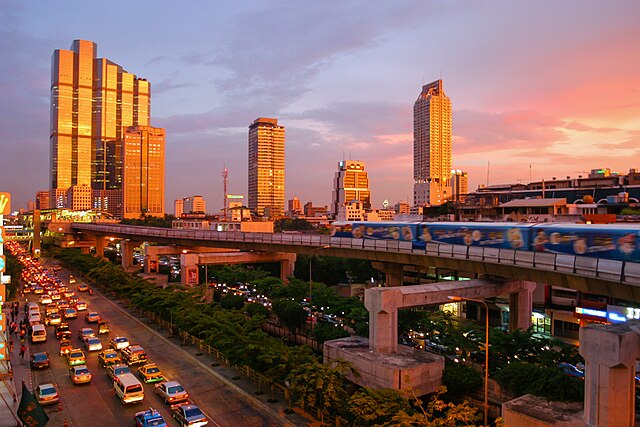
Once you're reached Bangkok, maybe you should know it's real name, as Bangkok is a name for the foreigners there, not the Thai people, who call the city ‘Krung Thep' or the longer version, ‘Krung Thep Maha Nakhon’ which means City of Angels. But nothing like the one in California. But even those two versions are not it's full name, as it has a Ceremonial Name, which is MUCH longer. In Thai script it is written as:
‘กรุงเทพมหานคร อมรรัตนโกสินทร์ มหินทรายุธยา มหาดิลกภพ นพรัตนราชธานีบูรีรมย์ อุดมราชนิเวศน์มหาสถาน อมรพิมานอวตารสถิต สักกะทัตติยวิษณุกรรมประสิทธิ์’
or in English text as:
‘Krungthepmahanakhon Amonrattanakosin Mahintharayutthaya Mahadilokphop Noppharatratchathaniburirom Udomratchaniwetmahasathan Amonphimanawatansathit Sakkathattiyawitsanukamprasit’
which consists of Pali and Sanskrit root words which could be translated as:
The city of angels, the great city, the residence of the Emerald Buddha, the impregnable city (of Ayutthaya) of God Indra, the grand capital of the world endowed with nine precious gems, the happy city, abounding in an enormous Royal Palace that resembles the heavenly abode where reigns the reincarnated god, a city given by Indra and built by Vishnukarn.
We will take you to see the Emerald Buddha while you are there, at the Royal Palace, of course!
The image is from Wikimedia.

Here I present my favorite film about Thailand in modern times. I believe it was produced by the Tourism Authority of Thailand and appeared on Facebook. Supattra sent it to me to watch in the months before I traveled to Thailand for the first time. I watched it many times! Eventually I visited some of the places featured in the film and you may too! I won't say anything else about it, so you can experience it for yourself. It took me a long time to find it again on the Internet. Originally it came in seven short pieces. I wish I could have found it in one piece, but the best I could do was to find it in three parts, as follows. When you watch each part, you will have to end that part and come back here to start the next part, or YouTube will start an unrelated video instead. It's very annoying, but it was the best I could do.
Part 1 of 3 : Part 2 of 3 : Part 3 of 3
You can read a little background about the film on this blog, but don't try to watch the film there, as you'll only see the very first part.
Anyway, I'm very glad I found the film again, it was full of happy memories for me. I really love this film!

As you walk inside the airport (the main Suvarnabhumi Airport in Bangkok in this case), you soon discover Thailand has gorgeous public art everywhere. This dramatic art shows detail of the asuras holding the head end of Vasuki, the king of serpents, to churn the ocean, right there in the middle of a wide walkway to and from the airplanes. You may notice it is also right in front of a Gucci retail store! But no worries, there will be plenty of affordable places to spend your money all over the country. This may look like a picture of real people, but it is actually a life-size diorama with amazing detail. If you want to learn how to pronounce the name of the airport, go here. If that's too hard for you, no problem. Just say B K K.
Image of art in the airport is from Wikimedia.
I'm putting a reference here, naming provinces that we have not yet visited together in Thailand. The full details can be found here, but the listing below is just shorthand to suggest new provinces we might want to visit in 2019, if they turn out to be nearby, or are on the way to somewhere else we are going. Many may be ones that we'll be unable to visit this year. But I'm thinking we will likely make it to some of the Central Provinces and for sure the last one in the Northern Province that we've not yet visited. So far we have been to 33 of the 76 provinces, plus to Bangkok, of course.
Central Provinces
Nakhon Nayok, Nakhon Pathom, Pathum Thani, Prachin Buri, Ratchaburi, Sa Kaew, & Saraburi.
Eastern Provinces
Chanthaburi, Rayong & Trat.
Northern Province
Phichit

I will update this page when there is current news about Thailand that might interest you. There are two links in blue below so far.
Thailand Does Not Have a Good Record on Privacy
24 Hr Reporting for Long-Term Expats
Thai Baht Strong Against the Dollar
Tourism Authority of Thailand Plan
To get details about any province, go to this view of the map and click on the name of any province that interests you.

This is the most important movie ever made about Thailand, made in 1979 for the BBC and first broadcast in 1980. It made me reallllly appreciate the love the Thai people have/had for their Royal family. The real power in Thailand rested in their King Rama IX, who reigned for more than 70 years and earned huge respect from his people, long before he passed away one day before my father passed on in October 2016. I saw this film after I had already been to Thailand, but I think it would be a good one for anyone to watch before actually going to Thailand for a visit.
If you've ever eaten at any Thai restaurants in America, you have likely seen framed pictures of the royal family.
Image of King Rama IX from Wikimedia.

Purpose of this Blog:
To provide visitors to Thailand with interesting information that might be useful before and/or during their visit to this amazing country. The navigation here is quite simple. Click on the large W6AZ to the left of Links up above and you will get a listing in reverse chronological order of all the postings here. Click on any article title to read just that posting. From any particular posting, you can go to the previous posting by clicking on the green arrow on the left side. To go to the next posting (later), click on the green arrow on the right side.
This software was written by Dave Winer, famous for being the first Internet blogger and for having created RSS, an essential tool for bloggers and readers of blogs, as well as having invented podcasting with Adam Curry in 2004. His Scripting News website is one that I followed daily for several years, during which time Dave developed many great tools for bloggers, this being one of them. Dave has routinely made his tools available to bloggers for free. I have tried many different blogging tools and blog websites over the years, but have come back to this one, as it is the best one for my purposes. I am very grateful to Dave for all his hard work in providing many tools to the blogging community, many of which I use frequently and routinely. Previously I posted My Ten Essentials for Travel in Thailand, using another one of Dave's blogging tools.
This particular instance of Dave's software is installed on a server I rent on the Internet, so I have control over what appears here. This part is entirely due to the hard work of Andy Sylvester, a software developer who I met through the Dave Winer blogging community, who configured the server for me and installed Dave's software on it. I made a number of attempts to configure a server myself, something which Dave Winer has encouraged over the years, but I'm a blogger and a tax accountant, not a software developer. So this blog truly would NOT be here, if it weren't for Andy's considerable help. Huge thanks to Andy!
Image by Anonymous (Thailand) - Walters Art Museum (via Wikimedia). In Thailand white elephants are considered sacred and are a symbol of royal power.